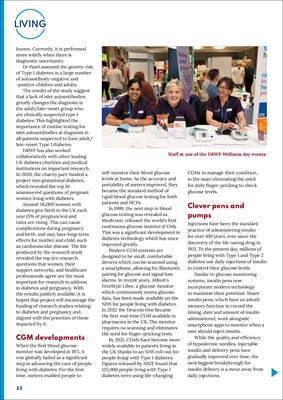
22
LIVING
known. Currently, it is performed
more widely when there is
diagnostic uncertainty.
Dr Patel assessed the genetic risk
of Type 1 diabetes in a large number
of autoantibody-negative and
-positive children and adults.
The results of the study suggest
that a lack of islet autoantibodies
greatly changes the diagnosis in
the adult/late-onset group who
are clinically suspected type 1
diabetes. This highlighted the
importance of routine testing for
islet autoantibodies at diagnosis in
all patients suspected to have adult/
late-onset Type 1 diabetes.
DRWF has also worked
collaboratively with other leading
UK diabetes charities and medical
institutions on important research.
In 2020, the charity part-funded a
project into gestational diabetes,
which revealed the top 10
unanswered questions of pregnant
women living with diabetes.
Around 38,000 women with
diabetes give birth in the UK each
year (5% of pregnancies) and
rates are rising. This can cause
complications during pregnancy
and birth, and may have long-term
effects for mother and child, such
as cardiovascular disease. The list
produced by the research study
revealed the top ten research
questions that women, their
support networks, and healthcare
professionals agree are the most
important for research to address
in diabetes and pregnancy. With
the results publicly available, it is
hoped that project will encourage the
funding of research studies relating
to diabetes and pregnancy and
aligned with the priorities of those
impacted by it.
CGM developments
When the first blood glucose
monitor was developed in 1971, it
was globally hailed as a significant
step in advancing the care of people
living with diabetes. For the first
time, meters enabled people to
self-monitor their blood glucose
levels at home. As the accuracy and
portability of meters improved, they
became the standard method of
rapid blood glucose testing for both
patients and HCPs.
In 1999, the next step in blood
glucose testing was revealed as
Medtronic released the world's first
continuous glucose monitor (CGM).
This was a significant development in
diabetes technology which has since
improved greatly.
Modern CGM systems are
designed to be small, comfortable
devices which can be scanned using
a smartphone, allowing for Bluetooth
pairing for glucose and signal loss
alarms. In recent years, Abbott's
FreeStyle Libre, a glucose monitor
which continuously stores glucose
data, has been made available on the
NHS for people living with diabetes.
In 2022 the Dexcom One became
the first real-time CGM available in
pharmacies in the UK. The monitor
requires no scanning and eliminates
the need for finger-pricking tests.
By 2021, CGMs have become more
widely available to patients living in
the UK thanks to an NHS roll-out for
people living with Type 1 diabetes.
Figures released by NICE found that
125,000 people living with Type 1
diabetes were using life-changing
CGMs to manage their condition,
in the main eliminating the need
for daily finger-pricking to check
glucose levels.
Clever pens and
pumps
Injections have been the standard
practice of administering insulin
for over 100 years, ever since the
discovery of the life-saving drug in
1921. To the present day, millions of
people living with Type 1 and Type 2
diabetes use daily injections of insulin
to control their glucose levels.
Similar to glucose monitoring
systems, insulin pens now
incorporate modern technology
to maximise their potential. Smart
insulin pens, which have an inbuilt
memory function to record the
timing, date and amount of insulin
administered, work alongside
smartphone apps to monitor when a
user should inject insulin.
While the quality and efficiency
of hypodermic needles, injectable
insulin and delivery pens have
gradually improved over time, the
next biggest breakthrough for insulin
delivery is a move away from daily
injections.
The only other alternative delivery
Staff at one of the DRWF Wellness day events.